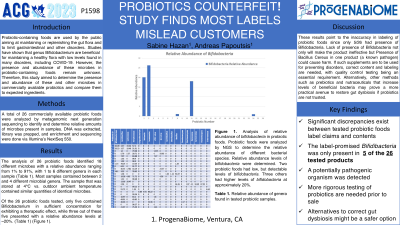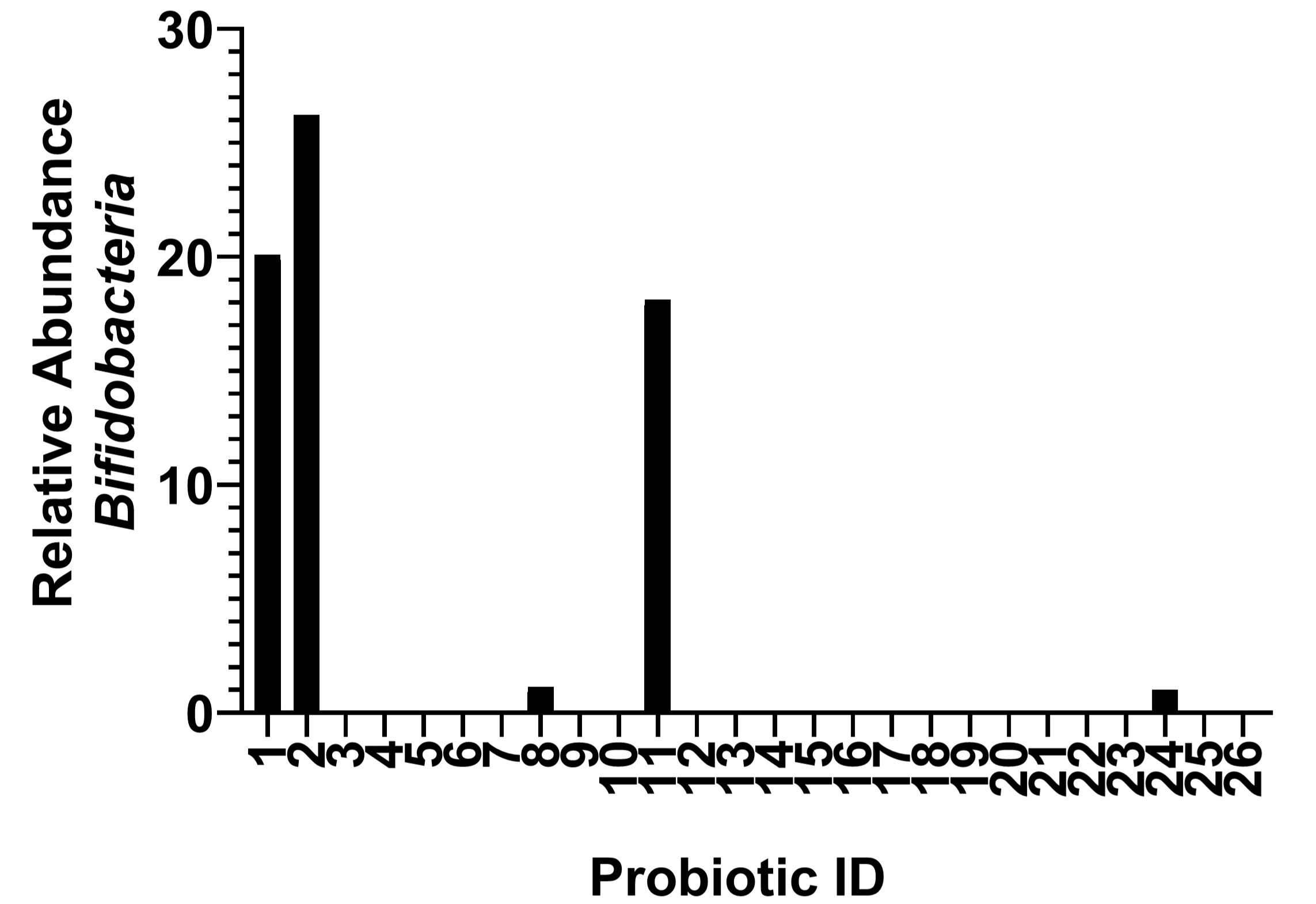Monday Poster Session
Category: Colon
P1598 - Probiotics Counterfeit! Study Finds Most Labels Mislead Customers
Monday, October 23, 2023
10:30 AM - 4:15 PM PT
Location: Exhibit Hall

Has Audio

Sabine Hazan, MD
ProgenaBiome
Ventura, California
Presenting Author(s)
Award: Presidential Poster Award
Sabine Hazan, MD, Andreas Papousis, PhD
ProgenaBiome, Ventura, CA
Introduction: Probiotic-containing foods are used by the public aiming at maintaining or replenishing the gut flora and to limit gastrointestinal and other disorders. Studies have shown that genus Bifidobacterium are beneficial for maintaining a healthy flora with low levels found in many disorders, including COVID-19. However, the presence and abundance of these microbes in probiotic-containing foods remain unknown. Therefore, this study aimed to determine the presence and abundance of these and other microbes in commercially available probiotics and compare them to expected ingredients.
Methods: A total of 26 commercially available probiotic foods were analyzed by metagenomic next generation sequencing to identify and determine relative amounts of microbes present in samples. DNA was extracted, library was prepped, and enrichment and sequencing were done via Illumina’s Nextseq 550.
Results: The analysis of 26 probiotic foods identified 18 different microbes with a relative abundance ranging from 1% to 91%, with 1 to 6 different genera in each sample (Table 1). Most samples contained between 2 and 4 different microbial genera. The sample that was stored at 4°C vs. outdoor ambient temperature contained similar quantities of identical microbes.
Of the 26 probiotic foods tested, only five contained Bifidobacterium in sufficient concentration for exhibiting a therapeutic effect, while three out of these five presented with a relative abundance levels at ~20%. (Table 1) (Figure 1).
Discussion: These results point to the inaccuracy in labeling of probiotic foods since only 5/26 had presence of Bifidobacteria. Lack of presence of Bifidobacteria not only will make the product ineffective but Presence of Bacillus Cereus in one product ( a known pathogen) could cause harm. If such supplements are to be used for preventing disorders, correct content and labeling are needed, with quality control testing being an essential requirement Alternatively, other methods such as prebiotics and nutraceuticals that increase levels of beneficial bacteria may prove a more practical avenue to restore gut dysbiosis if probiotics are not trusted.

Disclosures:
Sabine Hazan, MD, Andreas Papousis, PhD. P1598 - Probiotics Counterfeit! Study Finds Most Labels Mislead Customers, ACG 2023 Annual Scientific Meeting Abstracts. Vancouver, BC, Canada: American College of Gastroenterology.
Sabine Hazan, MD, Andreas Papousis, PhD
ProgenaBiome, Ventura, CA
Introduction: Probiotic-containing foods are used by the public aiming at maintaining or replenishing the gut flora and to limit gastrointestinal and other disorders. Studies have shown that genus Bifidobacterium are beneficial for maintaining a healthy flora with low levels found in many disorders, including COVID-19. However, the presence and abundance of these microbes in probiotic-containing foods remain unknown. Therefore, this study aimed to determine the presence and abundance of these and other microbes in commercially available probiotics and compare them to expected ingredients.
Methods: A total of 26 commercially available probiotic foods were analyzed by metagenomic next generation sequencing to identify and determine relative amounts of microbes present in samples. DNA was extracted, library was prepped, and enrichment and sequencing were done via Illumina’s Nextseq 550.
Results: The analysis of 26 probiotic foods identified 18 different microbes with a relative abundance ranging from 1% to 91%, with 1 to 6 different genera in each sample (Table 1). Most samples contained between 2 and 4 different microbial genera. The sample that was stored at 4°C vs. outdoor ambient temperature contained similar quantities of identical microbes.
Of the 26 probiotic foods tested, only five contained Bifidobacterium in sufficient concentration for exhibiting a therapeutic effect, while three out of these five presented with a relative abundance levels at ~20%. (Table 1) (Figure 1).
Discussion: These results point to the inaccuracy in labeling of probiotic foods since only 5/26 had presence of Bifidobacteria. Lack of presence of Bifidobacteria not only will make the product ineffective but Presence of Bacillus Cereus in one product ( a known pathogen) could cause harm. If such supplements are to be used for preventing disorders, correct content and labeling are needed, with quality control testing being an essential requirement Alternatively, other methods such as prebiotics and nutraceuticals that increase levels of beneficial bacteria may prove a more practical avenue to restore gut dysbiosis if probiotics are not trusted.

Figure: Figure 1. Analysis of relative abundance of bifidobacteria in probiotic foods. Probiotic foods were analyzed by NGS to determine the relative abundance of different bacterial species. Relative abundance levels of bifidobacteria were determined. Two probiotic foods had low, but detectable levels of bifidobacteria. Three others had higher levels of bifidobacteria at approximately 20%.
Disclosures:
Sabine Hazan indicated no relevant financial relationships.
Andreas Papousis indicated no relevant financial relationships.
Sabine Hazan, MD, Andreas Papousis, PhD. P1598 - Probiotics Counterfeit! Study Finds Most Labels Mislead Customers, ACG 2023 Annual Scientific Meeting Abstracts. Vancouver, BC, Canada: American College of Gastroenterology.

